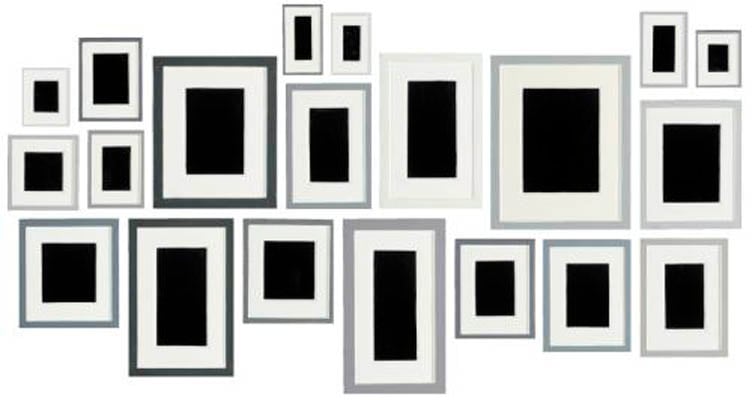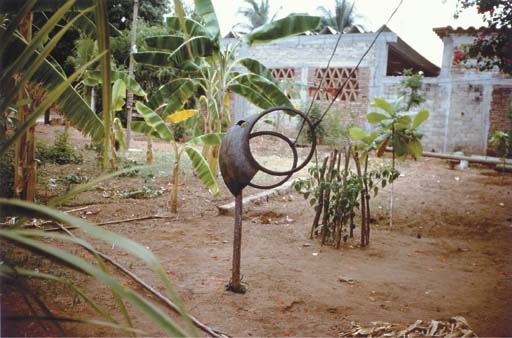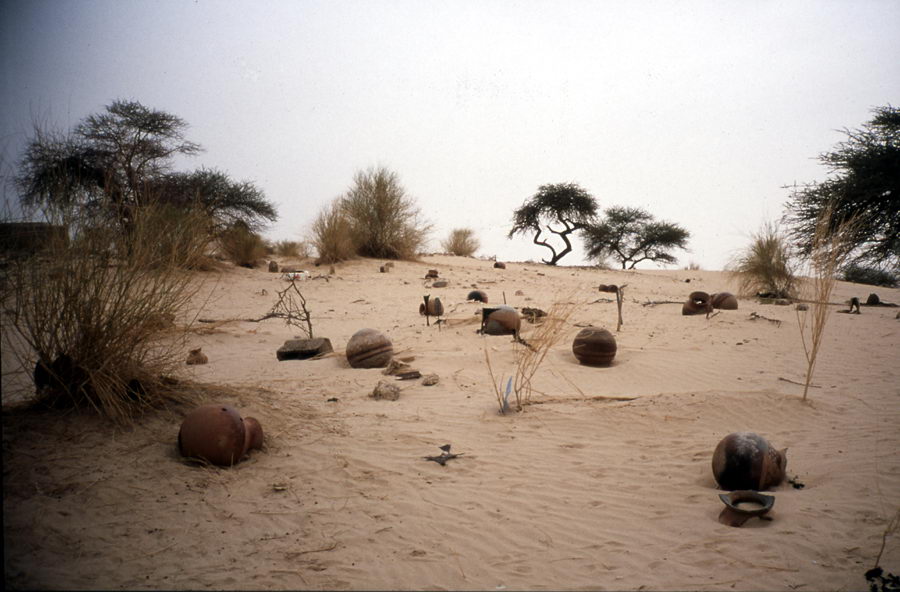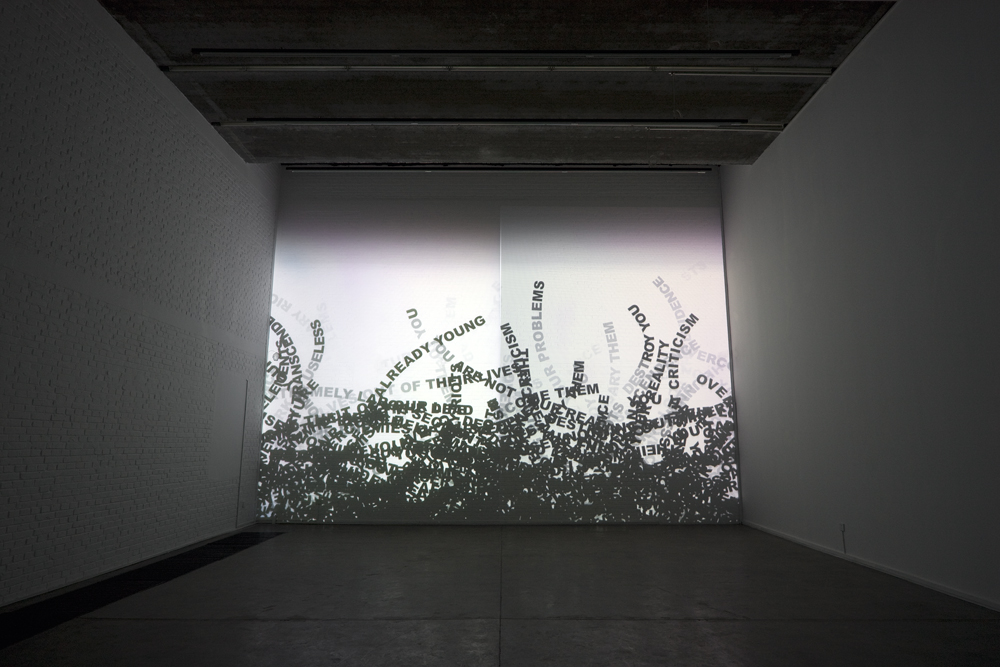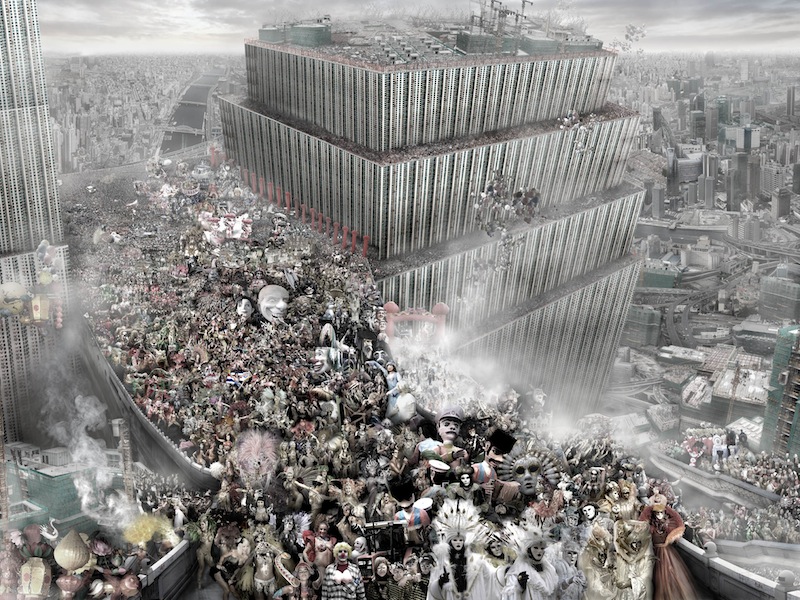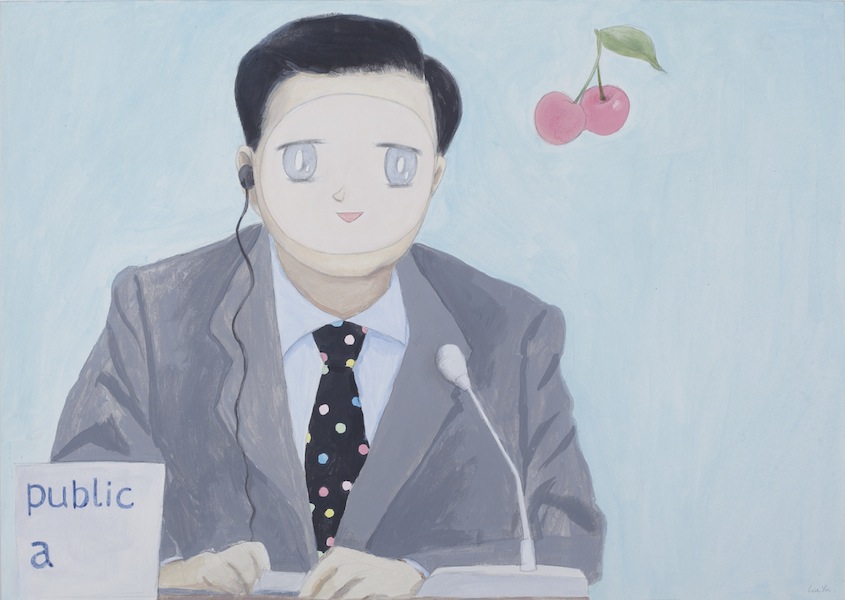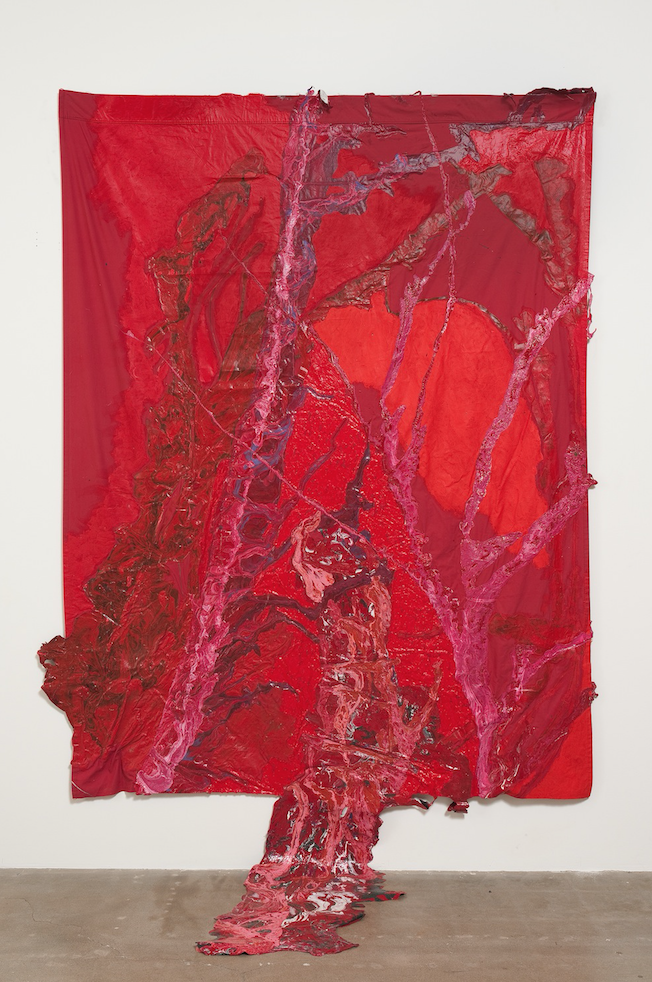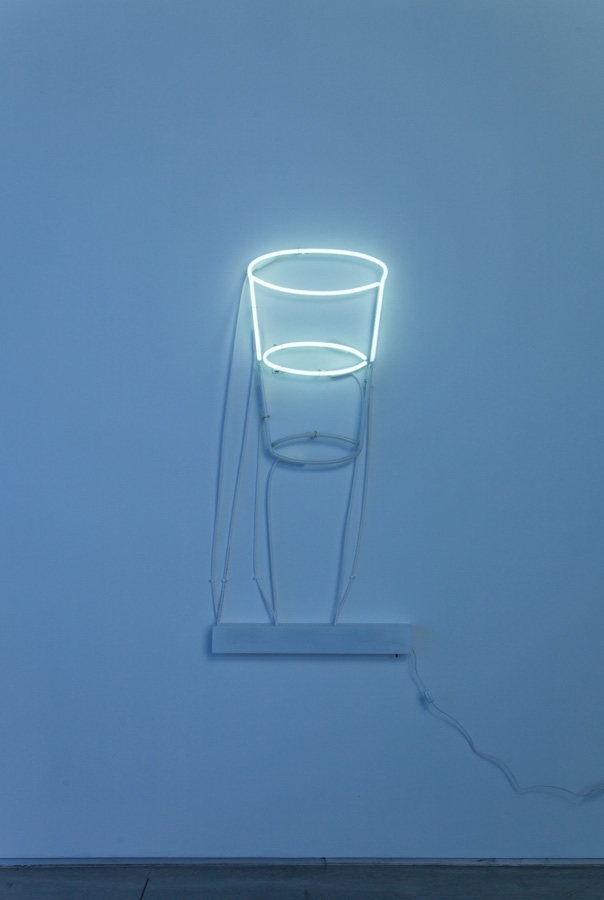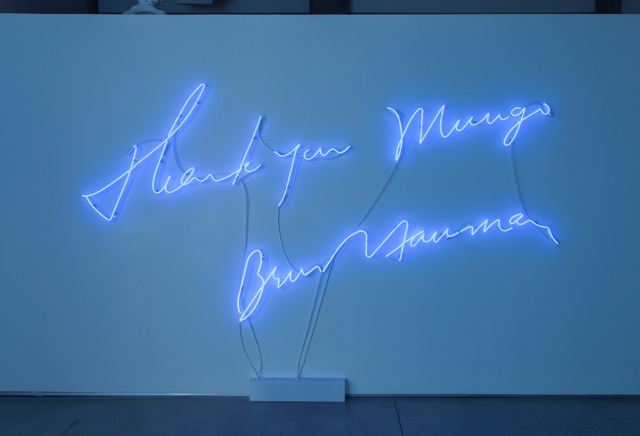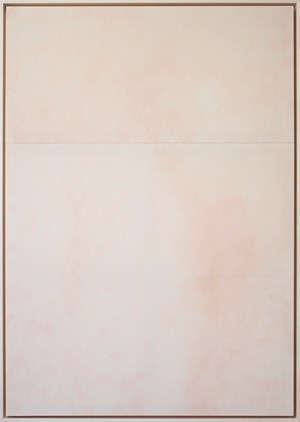
© » KADIST
Vincent Leong
The photograph Exquisite Eco Living is part of a larger series titled Executive Properties in which he digitally manipulated the images to insert iconic buildings of Kuala Lumpur in the view of derelict spaces also found in the city. This images reflect on a dystopian future of the country, perhaps drawing parallel with the political changes in Malaysia.

© » KADIST
Mateo Lopez
With Roca Carbon ( Charcoal Rock , 2012) and Roca Grafito ( Graphite Rock , 2012), López plays with our relationship to inert and unremarkable objects such as rocks. Traces of art history reverberate through the sculptures; their mediums reflect traditional materials for drawing and sketching, and the simplicity of their forms gesture toward minimalism. But López dislocates these common objects from their ordinary utility by replicating their component parts in paper, graphite, and charcoal, thus drawing attention to mechanisms of representation and translation.
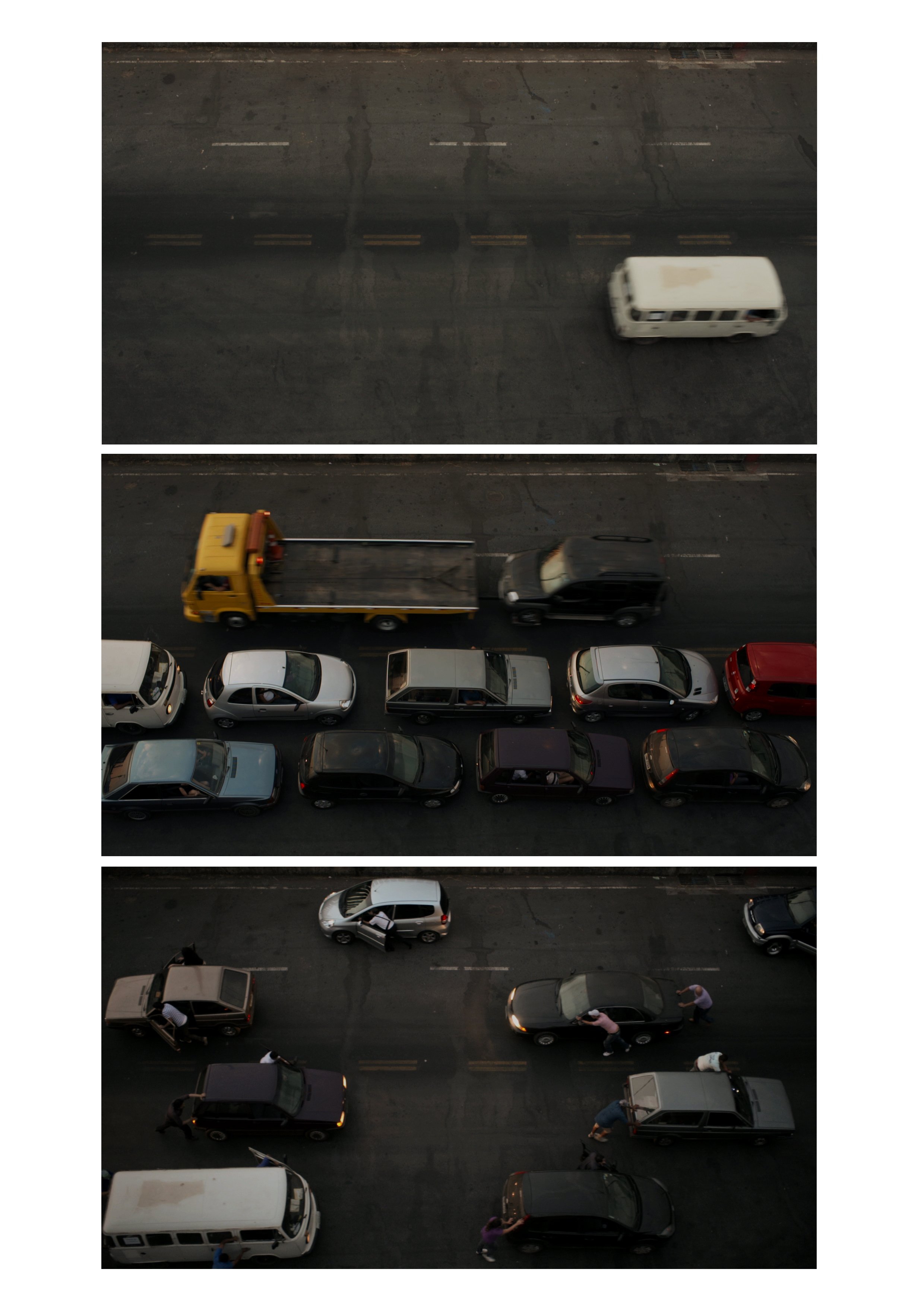
© » KADIST
Cinthia Marcelle
Cinthia Marcelle’s video work Automóvel (2012) re-edits the mundane rhythms of automotive traffic into a highly compelling and seemingly choreographed meditation on sequence, motion, and time. Shot from an aerial vantage, the camera tracks the daily commute on a small stretch of concrete highway. The camera films the traffic below in short five-second excerpts before blacking out; time begins to collapse as the video shifts between scene, and the hours compress into minutes as daylight quickly turns into night.

© » KADIST
Hamra Abbas
At first glance, Cityscapes (2010) seems to be a collection of panoramic photographs of the city of Istanbul—the kind that are found on postcards in souvenir shops. A closer examination, however, reveals that a key element—the minaret—has been systematically removed, thereby changing profoundly the history and religious character of the city. The work is a response to a November 2009 referendum in Switzerland that approved a ban on the construction of new minarets in that country.

© » KADIST
Wong Wai Yin
Drawn from the widely circulated images of protests around the world in support of women rights and racial equality, the phrase I can’t believe we are still protesting is both the title of Wong Wai Yin’s photographic series and a reference to similar messages seen on protest signages. The artist used found images from the internet, including a viral photo of an elderly woman who took part in the 2016 “Black Monday” strike against a proposed anti-abortion law in Poland, and another image taken the same year of a group of protestors in the United Kingdom, rallying for the Black Lives Matter movement. Drawing parallels with Hank Willis Thomas’s I Am a Man (2013) painting in the KADIST Collection, Wong employs the visual language and terminology of mass media, specifically borrowing images from protests on civil rights issues.

© » KADIST
Carlos Garaicoa
From the series the Old and the New (XI) by Carlos Garaicoa belongs to the series Lo viejo y lo nuevo / Das Alte und das Neue (The Old and the New) which was first exhibited in 2010 at Barbara Gross Gallery in Germany. Here, Garaicoa’s interest in vernacular Cuban architecture shifts towards the European context: a series of twelve nineteenth-century French engravings have been reworked into delicate paper models. Here, the two-dimensional old-school architectural renderings have become the foundation for new hollow three-dimensional structures.

© » KADIST
Mungo Thomson
Starting with Bruce Nauman’s iconic artwork, The True Artist Helps the World by Revealing Mystic Truths (Window or Wall Sign) , Mungo Thomson’s neon sign is one of a series that replaces Nauman’s quixotic mini-manifesto with aphorisms from ‘recovery’ culture, especially those made popular by alcoholics anonymous. Thomson is referencing the lore that Nauman’s work (the first of many neons he’d make in the following years) had been inspired by a neon beer sign found in a corner-store in San Francisco that he used as his studio in the late 60s. This particular work has a self-critical subtext, as it also suggests the act of using another artist’s work, in an endless spiral of influence, is akin to a form of insanity.

© » KADIST
Jiang Zhi
5 is a three channel video about the dualities of death and resurrection, reminiscence and fantasy, chronological and retrospective narration. The main video features two dancers intertwining, caressing in trancelike movements, with intimacy eventually leading to scarring and bleeding. Towards the end, the trace of bodily movements and fluids crescendo in an image of a skull in a synthesis of performance, painting and theater.

© » KADIST
Cerith Wyn Evans
Untitled (Perfect Lovers + 1) by Cerith Wyn Evans takes as its starting point Felix Gonzales-Torres’s seminal work Untitled (Perfect Lovers) , in which two clocks were synchronized and left to run without interference, the implication being that one would stop before the other. Gonzales-Torres’ original work was a personal allusion to his own partner’s increasingly debilitating HIV-related illness, which grapples with the existential tension of coexistence in the face of death. Cerith Wyn Evans’s piece takes the same concept, and adds a third clock, moving from the intimacy of a monogamous relationship to suggest a more expansive, or possibly polyamorous alternative.

© » KADIST
Ho Tzu Nyen
The Cloud of Unknowing (2011) is titled after a 14th-century medieval treatise on faith, in which “the cloud of unknowing” that stands between the aspirant and God can only be evoked by the senses, rather than the rational mind. In the video, eight protagonists act out their daily lives. The setting is a soon-to-be-demolished public housing facility in Singapore, a country in transition from a mindset of Eastern collectivism to global neoliberalism.

© » KADIST
Heman Chong
With a habit of reading eight to ten books at the same time, Chong paints his two-foot tall novel covers through referencing an extensive reading list (accessible on Facebook) he has kept since 2006. Entitled “Bibliography (1): The Lonely Ones,” the list outlines representations of solitude that has been imposed on individuals or communities. Chong divides these archetypes into three over-arching notions: the Hide-away, the Castaway and the Prisoner.

© » KADIST
Bernardo Ortiz
Drawing & Print (Drawing & Print)
Casa de la cabeza (2011) is a drawing of the words of the title, which translate literally into English as “house of the head.” Ortiz uses this humorous phrase to engage the idea of living in your head.

© » KADIST
Mungo Thomson
Drawing & Print (Drawing & Print)
The White Album (2008) presents a compilation of one hundred issues of Artforum magazine released between 1970 and 1979. As with Will Rogan’s MUM series, also included in the Kadist Collection, vital information is now missing: All of all the articles and features have been removed, leaving only ten years of advertisements. In an unusual way, The White Album reminds us that this important New York-focused magazine was originally founded in 1962 in San Francisco to promote Bay Area artists before it moved to Los Angeles in the mid-1960s in search of a wider advertising base.

© » KADIST
Yee I-Lann
7-headed Lalandau Hat by Yee I-Lann is an intricately woven sculpture evoking the ceremonial headdress worn by Murut men in Borneo. The materiality and form of this traditional headpiece represents the strength and fierceness of forest warriors. Their ‘chimneys’ on top are intended to resemble trees in the jungle onto which hornbill feathers would once have been stuffed.

© » KADIST
Piero Golia
Golia’s Untitled 3 is an installation in which a mechanical device is programmed to shoot clay pigeons that are thrown up in front of a white wall. More than a simple reference to the sport, the work has the disconcerting effect of creating a danger zone in the gallery space. The reference to direct aggression or violence is reinforced by the piece’s rapid pace.

© » KADIST
Carlos Amorales
Drawing & Print (Drawing & Print)
Produced on the occasion of an exhibition at ARTIUM of Alava, Basque Centre-Museum of Contemporary Art, this deck of cards is a selection of images from Carlos Amorales’s Liquid Archive. and abstract silhouetted motifs, in a black and white palette, are combined to create a world lodged between fantasy and reality typical of the tarot game. Airplanes, letters, naked women, Osama Bin Laden, Che Guevara, mythological figures, skulls, wrestlers’ masks are some of the visuals that populate this printed object.

© » KADIST
Natasha Wheat
Drawing & Print (Drawing & Print)
Natasha Wheat’s Kerosene Triptych (2011) is composed of three images, one each from the digital files of the Library of Congress, the Smithsonian Institution, and the Field Museum tropical research archive. The original photographs were taken by anonymous photographers, not as art but as documents of the building of the Panama Canal. The laborers in the images are holding cans of kerosene and spraying it into the foliage.

© » KADIST
Julieta Aranda
The video Swimming in rivers of Glue is composed of various images of nature, exploring the themes of exploration of space and its colonization. The images show the diversity of forms of life on earth. These forms are associated with texts that relay a form of propaganda.
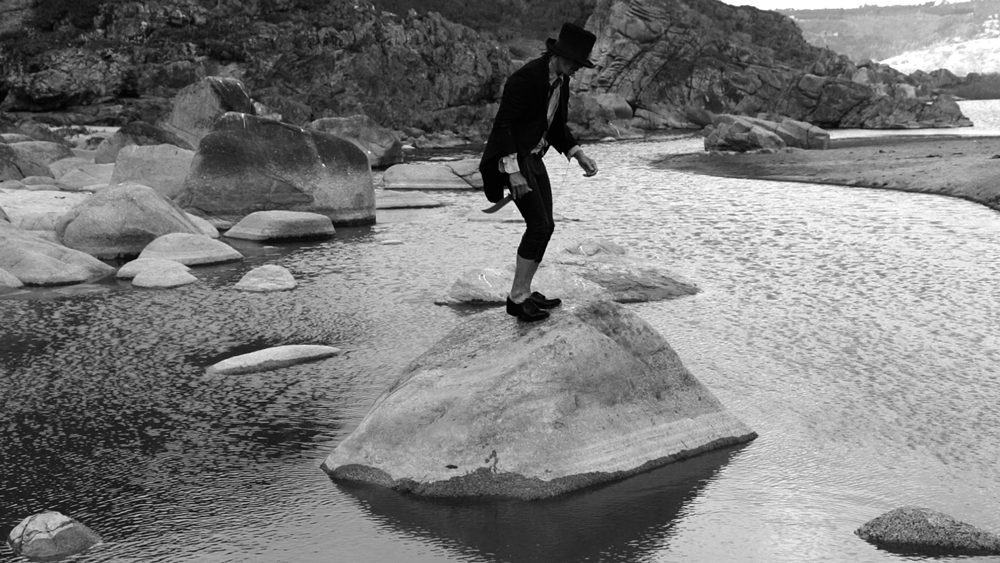
© » KADIST
Carlos Amorales
Carlos Amorales, based in Mexico City, works in many media and combinations thereof, including video, drawing, painting, photography, installation, animation, and performance. Central in his work is the construction and alteration of what he calls his Liquid Archive, a collection of images, narratives, drawings, shapes, and ideas that he uses to construct his unique visual language—a critical and stimulating space for fantasy, reality, and the blurring of the two. Amorales creates tensions between revealing and hiding the personal and the universal in his often-ambiguous and fluid constructions.

© » KADIST
Mario Garcia Torres
In Up All Night, Waiting for the Chelsea Hotel Magic to Spark My Creativity Mario García Torres constructs and documents a hypothetical scene, situating himself within a lineage of artists and creatives that used to congregate at the historic hotel. The long-exposure capture depicts García Torres at multiple stages of brainstorming, devising, and introspection, his ethereal figure connected with artistic giants of the past. Yet, there is also an insipid tone beyond mere insomnia or frustration at the lack of being able to garner inspiration.

© » KADIST
Yee I-Lann
Sarcastically titled to call attention to the problematic notions underlying colonialism, this photograph shows hundreds of Native Malaysians seated quietly behind one of their colonial oppressors. The artwork belongs to Yee’s series Picturing Power (2013) that deals with the destabilizing impacts of neo-colonialism and globalization on Southeast Asia’s history. Yee approaches the aesthetics and politics of the ethnographic gaze with both irony and humanity, challenging the modes of seeing inherent to the British colonization of Malaysia.

© » KADIST
Yee I-Lann
PANGKIS by Yee I-Lann is a looped video performance. The work is named after the triumphant warrior cry, an animistic guttural call, which punctuates the traditional Dusun Sumazau dance. For this work, the artist collaborated with Tagaps Dance Theatre, a group of young dancers whose practice merges traditional and contemporary styles.

© » KADIST
Gabriel Orozco
Gabriel Orozco often documents found situations in the natural or urban landscape. He travels armed with his camera and insightfully captures scenes of the everyday that other people might ignore. Perro en Tlalpan (Dog in Tlalpan, 1992) is a photograph of a dog regally perched under an industrial shelter in the borough of Tlalpan in Mexico City.

© » KADIST
Douglas Gordon
Blind Spencer is part of the series “Blind Stars” including hundreds of works in which the artist cut out the eyes of Hollywood stars, in a symbolically violent manner. An emptiness (some are burned letting appear a white or mirror background or a mirror) replaces the eyes, giving the impression of a blind eye deprived of all expression. Paradoxically, the work looks at us all the more intensely.

© » KADIST
Gabriel Orozco
Charco portátil congelado (Frozen Portable Puddle, 1994) is a photographic record of an installation of the same name that Gabriel Orozco made at Witte de With Center for Contemporary Art in Rotterdam for the group exhibition WATT (1994). The artist arrived a week prior to the opening with no artwork to install, and created three spontaneous works from locally sourced materials. This one was made of white plastic record sleeves that Orozco arranged on the damp roof of the gallery.

© » KADIST
Hank Willis Thomas
Drawing & Print (Drawing & Print)
Shot in black and white and printed on a glittery carborundum surface, Black Hands, White Cotton both confronts and abstracts the subject of its title. As with many of his works, the artist has taken a found image and manipulated it to draw out and dramatize the formal contrast between the black hands holding white cotton. Cotton, of course is one of the most familiar fabric sources to us, and becomes incredibly soft once processed.
Hank Willis Thomas
- location: New York, New York
- year born: 1976
- gender: male
- nationality: American
- home town: Plainfield, New Jersey
Wong Wai Yin
Wong Wai Yin is an interdisciplinary artist who experiments with a variety of media ranging from painting, sculpture, collage, performance, video, installations and photography...
Pedro Reyes
- location: Mexico City, Mexico
- year born: 1972
- gender: male
- nationality: Mexican
- home town: Mexico City, Mexico
Mungo Thomson
- location: Los Angeles, California
- year born: 1969
- gender: male
- nationality: American
Carlos Amorales
- year born: 1970
- gender: male
- nationality: Mexican
- home town: Mexico City, Mexico
Mario Garcia Torres
- location: Mexico City, Mexico
- year born: 1975
- gender: male
- nationality: Mexican
- home town: Monclova, Mexico
Julio Cesar Morales
- location: San Francisco, California
- year born: 1966
- gender: male
- nationality: Mexican
- home town: Tijuana, Mexico
Jonathan Monk
- location: Berlin, Germany
- year born: 1969
- gender: male
- nationality: British
- home town: Leicester, United Kingdom
Mateo Lopez
- location: Bogota, Colombia
- year born: 1978
- gender: male
- nationality: Colombian
- home town: Bogota, Colombia
Gabriel Orozco
- location: New York City, Paris
- location: Mexico
- year born: 1962
- gender: male
- nationality: Mexican
- home town: Jalapa, Mexico
Zanele Muholi
- year born: 1972
- gender: female
- nationality: South African
- home town: Umlazi, Durban, South Africa
Du Zhenjun
- location: Paris, France
- location: Shanghai, China
- year born: 1961
- gender: male
- nationality: Chinese
- home town: Shanghai, China
Koki Tanaka
- location: Los Angeles, California
- year born: 1975
- gender: male
- nationality: Japanese
- home town: Tochigi, Japan
Yee I-Lann
- location: Kuala Lumpur, Malaysia
- year born: 1971
- gender: female
- nationality: Malaysian
- home town: Sabah, Malaysia
Joachim Koester
- year born: 1962
- gender: male
- nationality: Danish
- home town: Copenhagen, Denmark
Douglas Gordon
- location: Berlin, Germany
- year born: 1966
- gender: male
- nationality: Scottish
- home town: Glasgow, United Kingdom
Fang Lu
Fang Lu uses intimacy as a place for self-expression in her videos and draws out mundane moments from everyday life as a strategy to heighten one’s awareness of existence from the rest of the world...
Kwan Sheung Chi
Kwan Sheung Chi obtained a third honor B.A...
Abraham Cruzvillegas
- location: Mexico
- year born: 1968
- gender: male
- nationality: Mexican
- home town: Mexico City, Mexico
Christine Sun Kim
- location: New York, New York
- year born: 1980
- gender: female
- nationality: American
- home town: Orange County, California
Runo Lagomarsino
- location: Malmo, Sweden
- location: Sao Paolo, Brazil
- year born: 1977
- gender: male
- nationality: Italian-Argentine-Swedish
- home town: Sweden
Heman Chong
- year born: 1977
- gender: male
- nationality: Singaporean
- home town: Muar, Malaysia
Yan Xing
- location: Beijing, China
- year born: 1986
- gender: male
- nationality: Chinese
- home town: Chongqing, China
Clarissa Tossin
- location: Los Angeles, California
- year born: 1973
- gender: female
- nationality: Brazilian
- home town: Porto Alegre, Brazil
Milena Bonilla
Milena Bonilla’s discursive practice explores connections among economics, territory, transit, and politics through everyday interventions...
Cerith Wyn Evans
- location: London, United Kingdom
- year born: 1958
- gender: male
- nationality: British
- home town: Llanelli, United Kingdom
Jiang Zhi
- location: Beijing
- location: Shenzhen, China
- year born: 1971
- gender: male
- nationality: Chinese
- home town: Yuanjiang, China
Rodney Graham
- location: Vancouver, Canada
- year born: 1949
- gender: male
- nationality: Canadian
- home town: Vancouver, Canada
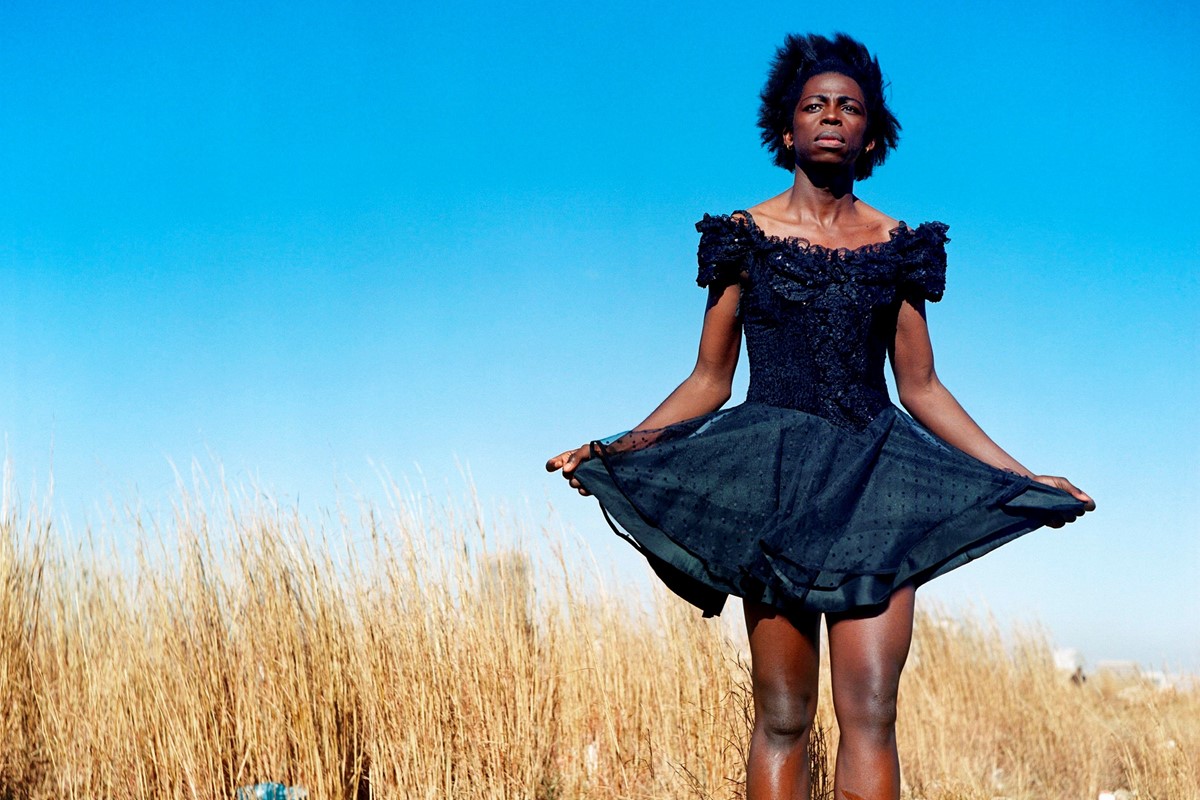
© » ANOTHER
about 17 months ago (02/12/2024)
Zanele Muholi’s Potent Portrait of South Africa’s Queer Community | AnOther As their new exhibition opens in San Francisco, Zanele Muholi talks about their powerful photos of queer survivors of hate crimes, couples in everyday moments, and self-portraits referencing history February 02, 2024 Text Emily Steer Zanele Muholi creates potent portraits...
-
1980-1989
Allan McCollum
1982In the work titled The Glossies (1980), an affinity for photography manifested itself before McCollum actually began to use photography as a medium...
-
1990-1999
Rodney Graham
1991Ponderosa Pine IV belongs to a series of large-scale photographs of trees taken by Graham and depicts a particular species that live in Northern California...
Gabriel Orozco
1992Gabriel Orozco often documents found situations in the natural or urban landscape...
Félix González-Torres
1992Behind the simplicity and beauty of this untitled photograph of a brilliantly-colored flowerbed by Félix González-Torres are two remarkable stories of love, loss, and resilience...
Gabriel Orozco
1994Charco portátil congelado (Frozen Portable Puddle, 1994) is a photographic record of an installation of the same name that Gabriel Orozco made at Witte de With Center for Contemporary Art in Rotterdam for the group exhibition WATT (1994)...
Jennifer Bornstein
1994Collectors’ Favorites is an episode of local cable program from the mid-1990s in which ordinary people were invited to present their personal collections—a concept that in many ways anticipates current reality TV shows and internet videos...
Douglas Gordon
1996In Monster (1996-97), the artist’s face becomes grotesque through the application of strips of transparent adhesive tape, typical of Gordon’s performance-based films that often depict his own body in action...
Rodney Graham
1996Tree on the Former Site of Camera Obscura (1996) belongs to a series of large-scale photographs of trees taken by Graham and depicts a particular species that lives in Northern California...
-
2000-2009
Douglas Gordon
2002Blind Spencer is part of the series “Blind Stars” including hundreds of works in which the artist cut out the eyes of Hollywood stars, in a symbolically violent manner...
Gabriel Orozco
2002Gabriel Orozco comments: “In the exhibition [Documenta 11, Kassel, 2002], I tried to connect with the photographs I took in Mali in July...
Jonathan Monk
2003Untitled (rolled up) , is an abstract portrait of Owen Monk, the artist’s father and features an aluminum ring of 56.6 cm in diameter measuring 1.77 cm in circumference, the size of his father...
Mario Garcia Torres
2004Mario Garcia Torres imagines cinematic devices to replay stories occasionally forgotten by Conceptual art...
Francis Alÿs
2004The Nightwatch , which is an ironic reference to the celebrated painting by Rembrandt, follows the course of a fox wandering among the celebrated collections of the National Portrait Gallery in London...
Tino Sehgal
2004Tino Sehgal’s This Exhibition requires an interpreter (in this particular piece, a gallery attendant) to faux faint each and every time a visitor enters into a given space...
Douglas Gordon
2004Douglas Gordon’s single-channel video The Left Hand Can’t See That The Right Hand is Blind, captures an unfolding scene between two hands in leather gloves—at first seemingly comfortable to be entwined, and later, engaged in a struggle...
Abraham Cruzvillegas
2004Wright Imperial Hotel (2004) is a sort of bow and arrow made out of feathers, a São Paulo phone book, and other materials...
Carlos Amorales
Drawing & Print
2005(Drawing & Print) Produced on the occasion of an exhibition at ARTIUM of Alava, Basque Centre-Museum of Contemporary Art, this deck of cards is a selection of images from Carlos Amorales’s Liquid Archive...
Pedro Reyes
2005In Reyes’s words, “We should be able to extract the technological nutrients before we excrete our waste...
Mario Garcia Torres
2005Mario Garcia Torres films a game of Charades among professional actors guessing the former North Korean dictator’s favorite Hollywood films...
Francis Alÿs
Drawing & Print
2006(Drawing & Print) This series of small drawings is executed with varying materials—pen, ink, colored pencil, charcoal, and masking tape—on architect’s tracing paper...
Qing Zhang
2006603 Football Field presents a soccer game played inside a small student apartment in Shanghai...
Joachim Koester
2006Physical and mental exploration have been founding elements in Joachim Koester’s research for several years...
Carlos Amorales
2006This work, a large oil painting on canvas, shows a moment from Amorales’s eight-minute two-channel video projection Useless Wonder (2006)...
Edgar Arceneaux
Drawing & Print
2006(Drawing & Print) Untitled (Wheelchair Drawing) is a ten-foot photo transfer of the image of a wheelchair with burning embers in its seat...
Julio Cesar Morales
Drawing & Print
2006(Drawing & Print) Julio Cesar Morales’s watercolor drawings, Undocumented Intervention , show a variety of surprising hiding places assumed by people trying to cross into the United States without documentation...
Piero Golia
2007Golia’s Untitled 3 is an installation in which a mechanical device is programmed to shoot clay pigeons that are thrown up in front of a white wall...
Joachim Koester
2007Tarantism is the name of disease which appeared in southern Italy, resulting from the bite of a spider called Tarantula...
Carlos Amorales
2007This work, a large oil painting on canvas, shows a moment from Amorales’s eight-minute two-channel video projection Useless Wonder (2006)...
Kwan Sheung Chi
2007A Flags-Raising-Lowering Ceremony at my home’s cloths drying rack (2007) was realized in the year of the 10th anniversary of the establishment of The Hong Kong Special Administrative Region of the People’s Republic of China...
Cerith Wyn Evans
2008Untitled (Perfect Lovers + 1) by Cerith Wyn Evans takes as its starting point Felix Gonzales-Torres’s seminal work Untitled (Perfect Lovers) , in which two clocks were synchronized and left to run without interference, the implication being that one would stop before the other...
Mungo Thomson
Drawing & Print
2008(Drawing & Print) The White Album (2008) presents a compilation of one hundred issues of Artforum magazine released between 1970 and 1979...
Julio Cesar Morales
2008The video Interrupted Passage presents a performance Morales staged in the former home of Mariano Guadalupe Vallejo, a mid-nineteenth-century Mexican general serving in California...
Wong Wai Yin
2008In this work the artist stages a humorously violent “intervention” against male-dominated cultures of art production in present-day China...
Heman Chong
2009With a habit of reading eight to ten books at the same time, Chong paints his two-foot tall novel covers through referencing an extensive reading list (accessible on Facebook) he has kept since 2006...
Mario Ybarra Jr.
2009Ammo Bunker (2009) is a multipart installation that includes large-scale wall prints and an architectural model...
Yoshua Okón
2009Canned Laughter was Okón’s response to an invitation from Ciudad Juárez , Mexico, where artists were asked to create works based on their experience of the city...
Yang Xinguang
2009Although seemingly unadorned at first glance, Yang Xinguang’s sculptural work Phenomena (2009) employs minimalist aesthetics as a means of gesturing towards the various commonalities and conflicts between civilization and the natural world...
Milena Bonilla
Drawing & Print
2009(Drawing & Print) Milena Bonilla’s discursive practice explores connections among economics, territory, and politics through everyday interventions...
Geoffrey Farmer
2009Ongoing Time Stabbed with a Dagger was Farmer’s first kinetic sculpture that added a cinematic character to an “ever-reconfiguring play presented in real time.” The assembly of various objects and props on top of a large platform constitutes not only a work, but, to a certain extent, a show in itself...
Koki Tanaka
2009Walking Through is one of a series of videos—sometimes humorous, often absurd—that record the artist’s performative interactions with objects in a particular site...
-
2010-2019
Carlos Garaicoa
2010From the series the Old and the New (XI) by Carlos Garaicoa belongs to the series Lo viejo y lo nuevo / Das Alte und das Neue (The Old and the New) which was first exhibited in 2010 at Barbara Gross Gallery in Germany...
Hamra Abbas
2010At first glance, Cityscapes (2010) seems to be a collection of panoramic photographs of the city of Istanbul—the kind that are found on postcards in souvenir shops...
Mario Garcia Torres
2010In Up All Night, Waiting for the Chelsea Hotel Magic to Spark My Creativity Mario García Torres constructs and documents a hypothetical scene, situating himself within a lineage of artists and creatives that used to congregate at the historic hotel...
Mungo Thomson
2010In Thomson’s Untitled (TIME) , every front cover of TIME magazine is sequentially projected to scale at thirty frames per second...
Mauricio Ancalmo
2010War Footage is a series of wall-mounted works composed of 16mm film leader, tightly bound to flag-shaped panels by the artist...
Zarouhie Abdalian
2010The first iteration of Flutter was specifically conceived for the Pro Arts Gallery space in Oakland in 2010, viewable from the public space of a sidewalk, and the version acquired by the Kadist Collection is an adaptation of it...
Du Zhenjun
2010The Tower of Babel is an installation of large-format photographs that forces the audience to occupy a central position through its monumental scale...
Du Zhenjun
2010The Tower of Babel is an installation of large-format photographs that forces the audience to occupy a central position through its monumental scale...
Koki Tanaka
2010Tanaka’s unique understanding of objects and materials is reflected in the four photographs that document his Process of Blowing Flour ...
Du Zhenjun
2010The Tower of Babel is an installation of large-format photographs that forces the audience to occupy a central position through its monumental scale...
Natasha Wheat
Drawing & Print
2011(Drawing & Print) Natasha Wheat’s Kerosene Triptych (2011) is composed of three images, one each from the digital files of the Library of Congress, the Smithsonian Institution, and the Field Museum tropical research archive...
Ho Tzu Nyen
2011The Cloud of Unknowing (2011) is titled after a 14th-century medieval treatise on faith, in which “the cloud of unknowing” that stands between the aspirant and God can only be evoked by the senses, rather than the rational mind...
Bernardo Ortiz
Drawing & Print
2011(Drawing & Print) Casa de la cabeza (2011) is a drawing of the words of the title, which translate literally into English as “house of the head.” Ortiz uses this humorous phrase to engage the idea of living in your head....
Natasha Wheat
2011Wheat’s work is built on a strong conceptual framework that weaves together commentary on social and political issues and the radical potential for change...
Julio Cesar Morales
2011Contrabando is a work that references the larger sociological phenomenon in which immigrant economic strategies come to infiltrate urban landscapes...
Lucas Blalock
2011Compositions such as Tree on Keystone (2011) become hyperreal versions of their real-world equivalents...
Vincent Leong
2012The photograph Exquisite Eco Living is part of a larger series titled Executive Properties in which he digitally manipulated the images to insert iconic buildings of Kuala Lumpur in the view of derelict spaces also found in the city...
Cinthia Marcelle
2012Cinthia Marcelle’s video work Automóvel (2012) re-edits the mundane rhythms of automotive traffic into a highly compelling and seemingly choreographed meditation on sequence, motion, and time...
Mateo Lopez
2012With Roca Carbon ( Charcoal Rock , 2012) and Roca Grafito ( Graphite Rock , 2012), López plays with our relationship to inert and unremarkable objects such as rocks...
Yang Zhenzhong
2012Peasant Sensation Passing Through Flesh – 3 consists of a massage chair fixed to a wall...
Pedro Reyes
2012Pedro Reyes’s Los Mutantes ( Mutants , 2012) is composed of 170 plates that combine characters from ancient and modern mythologies...
Heman Chong
2012The work Calendars is composed of 1001 images of deserted public areas in Singapore printed on pages of a calendar set from the year of 2020 until 2096...
Oded Hirsch
2012Oded Hirsch’s video work Nothing New (2012) utilizes seemingly absurdist tropes to raise more trenchant questions about communal action and collective identity in modern day Israel...
Hank Willis Thomas
Drawing & Print
2012(Drawing & Print) Intentionally Left Blanc alludes to the technical process of its own (non)production; a procedure known as retro-reflective screen printing in which the image is only fully brought to life through its exposure to flash lighting...
Kwan Sheung Chi
2012Kwan Sheung Chi’s work One Million is a video work depicting the counting of bills...
Hank Willis Thomas
Drawing & Print
2012(Drawing & Print) Thomas’ lenticular text-based works require viewers to shift positions as they view them in order to fully absorb their content...
Clarissa Tossin
2012In Fordlândia Fieldwork (2012), Tossin documents the remains of Henry Ford’s rubber enterprise Fordlândia, built in 1928 in the Brazilian Amazon to export cultivated rubber for the booming automobile industry...
Adrian Wong
2012Untitled (Grate I/II: Shan Mei Playground/ Grand Fortune Mansion) is part of a series drawn from architectural objects that mark the boundary of public and private spaces Wong encountered while strolling in Hong Kong...
Hank Willis Thomas
2012Bread and Roses takes its name from a phrase famously used on picket signs and immortalized by the poet James Oppenheim in 1911...
Hank Willis Thomas
2012Like many of his other sculptural works, the source of I am the Greatest is actually a historical photograph of an identical button pin from the 1960s...
Mateo Lopez
2012With Roca Carbón (Charcoal Rock, 2012) and Roca Grafito ( Graphite Rock , 2012), López plays with our relationship to inert and unremarkable objects such as rocks...
Nicolás Paris
2012Nicolas Paris studied architecture and worked as an elementary school teacher before he decided to become an artist...
Valeska Soares
2012Relying on repetition and repurposed materials, Soares works to interrogate time—its measurement, its passing, and its meaning...
Yee I-Lann
2013Sarcastically titled to call attention to the problematic notions underlying colonialism, this photograph shows hundreds of Native Malaysians seated quietly behind one of their colonial oppressors...
Hank Willis Thomas
2013The image is borrowed from protests during Civil Rights where African Americans in the south would carry signs with the same message to assert their rights against segregation and racism...
Lucas Blalock
Drawing & Print
2013(Drawing & Print) Blalock resists the immediacy that we have come to expect from photography—that each photograph should communicate its message without delay...
Rodney McMillian
2013In his evocative Landscape Paintings, McMillian uses second-hand bedsheets, sourced from thrift shops, as his starting point...
Amalia Pica
2013Memorial for intersections #2 (2013) is a minimalist, black metallic structure that contains the brightly colored translucent circles, triangles, rectangles, and squares that originally were presented in Pica’s performance work A ? B ? C (2013)...
Koki Tanaka
2013This artwork was part of a group of projects presented in the Japanese Pavilion at the Venice Biennale in 2013...
Kori Newkirk
2013LAB (2013) conjures the body as the trace of a sooty hand appears, spectrally, on a crumpled paper towel...
Mungo Thomson
2014Starting with Bruce Nauman’s iconic artwork, The True Artist Helps the World by Revealing Mystic Truths (Window or Wall Sign) , Mungo Thomson’s neon sign is one of a series that replaces Nauman’s quixotic mini-manifesto with aphorisms from ‘recovery’ culture, especially those made popular by alcoholics anonymous...
Carlos Amorales
2014Carlos Amorales, based in Mexico City, works in many media and combinations thereof, including video, drawing, painting, photography, installation, animation, and performance...
Hank Willis Thomas
Drawing & Print
2014(Drawing & Print) Shot in black and white and printed on a glittery carborundum surface, Black Hands, White Cotton both confronts and abstracts the subject of its title...
Zanele Muholi
2014As a visual activist for the rights of Lesbian, gay, bisexual, transgender, queer and intersex (LBGTQI), Muholi’s photographs radically transgress the conventional perception of lesbian and transgender communities in South Africa...
Zanele Muholi
2014As a visual activist for the rights of Lesbian, gay, bisexual, transgender, queer and intersex (LBGTQI), Muholi’s photographs radically transgress the conventional perception of lesbian and transgender communities in South Africa...
Zanele Muholi
2014As a visual activist for the rights of Lesbian, gay, bisexual, transgender, queer and intersex (LBGTQI), Muholi’s photographs radically transgress the conventional perception of lesbian and transgender communities in South Africa...
Hank Willis Thomas
2014South Africa Righteous Space by Hank Willis Thomas is concerned with history and identity, with the way race and ‘blackness’ has not only been informed but deliberately shaped and constructed by various forces – first through colonialism and slavery, and more recently through mass media and advertising – and reminds us of the financial and economic stakes that have always been involved in representations of race....
Yoshua Okón
2015Fridge-Freezer is a 2-channel video installation where Yoshua Okón explores the darker side of suburbia, d escribed by the artist as “ the ideal environment for a numb existence of passive consumerism and social a nd environmental disengagement...
Julieta Aranda
2016The video Swimming in rivers of Glue is composed of various images of nature, exploring the themes of exploration of space and its colonization...
Simon Fujiwara
2016Masks is a series of abstract paintings by Simon Fujiwara that together form a giant, fragmented portrait of German Chancellor Angela Merkel’s face...
Clarissa Tossin
2017Clarissa Tossin’s film Ch’u Mayaa responds to Frank Lloyd Wright’s Hollyhock House (constructed 1919–21) in Los Angeles, an example of Mayan Revival architecture...
Agnieszka Kurant
Drawing & Print
2018(Drawing & Print) Agnieszka Kurant’s Placebo VIII brings together a series of imaginary pharmaceuticals invented within the fictional narratives of literature and film...
-
2020-2029
Yee I-Lann
20207-headed Lalandau Hat by Yee I-Lann is an intricately woven sculpture evoking the ceremonial headdress worn by Murut men in Borneo...
Runo Lagomarsino
Drawing & Print
2020(Drawing & Print) On Fire by Runo Lagomarsino comprises twenty pieces of parchment, each of which has had the contours and map of Brazil burned in stages...
Runo Lagomarsino
2020Yo también soy humo (I am also smoke) is a 16mm film that has been digitized to video...
Wong Wai Yin
2021Drawn from the widely circulated images of protests around the world in support of women rights and racial equality, the phrase I can’t believe we are still protesting is both the title of Wong Wai Yin’s photographic series and a reference to similar messages seen on protest signages...
Wong Wai Yin
2021Drawn from the widely circulated images of protests around the world in support of women rights and racial equality, the phrase I can’t believe we are still protesting is both the title of Wong Wai Yin’s photographic series and a reference to similar messages seen on protest signages...
Wong Wai Yin
2021Drawn from the widely circulated images of protests around the world in support of women rights and racial equality, the phrase I can’t believe we are still protesting is both the title of Wong Wai Yin’s photographic series and a reference to similar messages seen on protest signages...
Wong Wai Yin
2021Drawn from the widely circulated images of protests around the world in support of women rights and racial equality, the phrase I can’t believe we are still protesting is both the title of Wong Wai Yin’s photographic series and a reference to similar messages seen on protest signages...
Christine Sun Kim
2022Hand Palm Echo 1 is a digital animation based on Christine Sun Kim’s staircase mural at The Drawing Center in New York (10 March – 22 May, 2022)...
Agnieszka Kurant
2022For Sentimentite Agnieszka Kurant collaborated with Justin Lane, CEO and Co-Founder of CulturePulse, to gather global sentiment data that has been harvested from millions of Twitter and Reddit posts related to 100 seismic events in recent history...
Agnieszka Kurant
2022For Sentimentite Agnieszka Kurant collaborated with Justin Lane, CEO and Co-Founder of CulturePulse, to gather global sentiment data that has been harvested from millions of Twitter and Reddit posts related to 100 seismic events in recent history...
Agnieszka Kurant
2022For Sentimentite Agnieszka Kurant collaborated with Justin Lane, CEO and Co-Founder of CulturePulse, to gather global sentiment data that has been harvested from millions of Twitter and Reddit posts related to 100 seismic events in recent history...

























